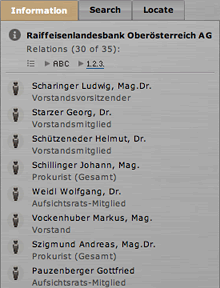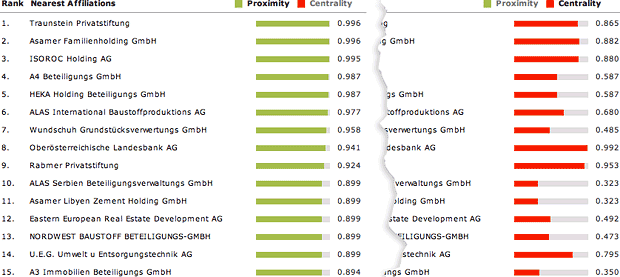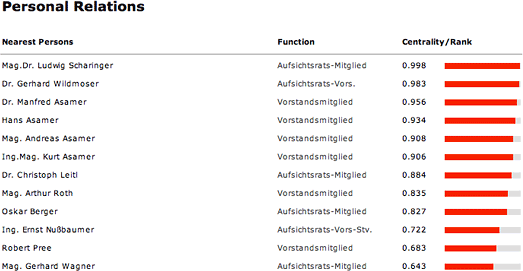Reports
1) Accessing the Report
You can access a report in various ways: It's at your finger tips almost anytime. You may access it by the contextual menu of a node, by selecting the contextual menu anywhere you find an element's name as an item of a list. Most simply you just click a node to select it and double click its name as it shows up at the head of the info-panel:

You may also click the info-icon in front of the name of the selected element.
Anyway you access it, the report will open in an extra window.
2) Sections of the Report
The report is organized in 3 sections:
- The overview with a compilation of statistical key data.
- The centrality report on the specific position of this player in the network.
- The list relations.
Using the link-buttons in the head of the report you may switch quickly from one section to the other.
2.1 Overview
This section is shown as the report window is opened the data loaded.
It shows – depending on the type of element " some statistical key data which describe the element:
2.1.1 Key Data available for Affiliation
| • | ZIP, city, district | The location of the company or foundation | |
| • | Address (street) | Street and number | |
| • | Register ID | The ID in the Austrian register of companies. | |
| • | Legal form | The legal form of the company. | |
| • | Economic sector | The ordinal number of the sector the corporation is mainly active in. | |
| • | Branch, trade (Ö-NACE Code) | The branch of the companies activities. | |
| • | Turnover | Turnover in EURO, if there is data available | |
| • | Employees | Number of employees, if there is data available | |
| • | Rank | Global rank (by weight of influence) |
2.1.2 Key Data for Persons
| • | Date of birth | The date of birth according to the register of companies. | |
| • | Gender | Abbreviated: "m" - male, "f" - female | |
| • | Rank | Global rank (by weight of influence) |
2.2 Centralities / Influence in Austria
The Centrality Report consists of two parts: the table of influence and the scale of Centrality Temperatures.
2.2.1 The Table of Influence
Influence leads from person to person and from affiliation to affiliation (cf: Influence and Proximity in Networks). Accordingly this table shows for persons a lists of persons and for affiliations a list of affiliations.
The table's items are sorted by the rank of proximity, which measures the distance between the players. You can see this measure as a bar and as numeric index at the right side of an item's name. (The bigger a bar and the higher the value the more ties exist between the player the report is about and the player listed in the table.)
At the right side of the table's head you can switch the index to be displayed. By switching to "Centrality" the color of the bars change to red and the values of the global centrality (weight of influence) for each of the items is displayed. (The sorting order does not change.)
This way you can judge the importance of each individual player listed in the table.

Table of influence for an affiliation showing values for proximities (left side) and influence (right side)
By right clicking an item a contextual menu provides the same options as for any list view: You may chose to show the report on this element, display a new map with this element in the center, copy the item's label, or start a Google search on it.
Please note that the options "New map ..." and "Show report ..." will close the current report window.
2.2.2 The Scale of Centrality Temperatures
The "Centrality Temperatures" show the specific position of the player in the field of Austrian economy:

The color of the columns correspond to the value of the individual scales (red: high, yellow: low). As you move the mouse pointer onto a column its value is displayed in percents of the scale's maximum.
The scales of the "Centrality Temperatures" have the following meaning:
| • | Centrality | The global weight of influence in the network. (100% corresponds to the highest rank in the entire network.). Influence is not always synonymous with power, it also depicts some dependency as the player is intensely integrated in the network. The two other scales give more information on this aspect: |
|
| • | Clique-Memberships | This is an index for how tightly integrated this player is in various cliques and local structures. A high value indicates that this player may influence others of same breed or business. | |
| • | Opportunities | A high value indicates that this player has maintained a certain freedom of action by the specific mix of relations. This player also reaches as a broker into distinct parts of the network. (A player with relations just to a single clique is likely to depend on it. It might be assumed that such a player has not as many opportunities of action.) |
2.3 Relations
The list of relations shows the elements the affiliation or person is directly connected to by the ties of institutional relations. For an affiliation these are persons, for a person these are affiliations. The relations correspond to the entries in the Austrian register of companies.
This list shows the related persons or affiliation and the type of institutional relation that establishes this tie. The table is sorted by global rank (weight of influence):

Persons related to an affiliation:
The most important person related to this corporation is Mr. Scharinger, member of the board,
second ranked is Mr. Wildmoser, who is chair member of the board, etc.
By right clicking an item a contextual menu provides the same options as for any list view: You may chose to show the report on this element, display a new map with this element in the center, copy the item's label, or start a Google search on it.